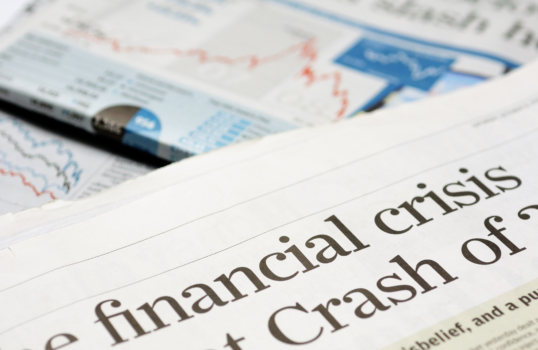BOOK REVIEW: Easy Money and Hard Economic Times
Editors’ Note: As the article below indicates, a new magisterial history of interest rates and central banking has been published. The author, Edward Chancellor wrote a previous book just before the last great financial crash called Devil Take the Hindmost, which was extremely timely if not prescient. This new book is extremely critical of current central bank policies, which have caused a serial set of financial bubbles, that have caused immense economic distortions setting us up for another crisis and putting governments themselves into a debt trap. As this book is beginning to get recognized, the shallowness of our institutions is once again revealed. The Nobel Committee has awarded the Nobel Prize in Economics to former Fed Chair Ben Bernanke, considered the architect of Quantitative Easing, at least in the West. This is roughly equivalent to presenting the Sherwin – Williams award for painting, to a house painter who painted himself into a corner all while setting the house on fire.
A brilliant book explains the causes of our economic travails and names names.
- It is longer than a tweet, a text, a TikTok, a YouTube, or a news blurb.
- It requires a basic understanding of finance, economics, statistics, and multi-syllable words.
- It makes the reader feel intellectually inadequate at times, especially this reader of mediocre intelligence.
- It is nonpartisan and criticizes both political parties as warranted.
- It is not about race, gender, Elon Musk, Donald Trump, the Kardashians, or sports celebrities.
- As a result, it’s not going to be a best-seller.
- What is it? It is the following masterpiece:
The Price of Time: The Real Story of Interest, by Edward Chancellor, Atlantic Monthly Press, 2022, 398 pages.
It’s a shame that the book won’t be a best-seller, for it explains the major causes of flat-lined productivity, of slow economic growth, of the corruption of capitalism, of income inequality, of bubbles in real estate and other assets, of the financialization of the economy, of leveraged buyouts and mergers and acquisitions that hollow out companies and stifle competition, of sky-high stock valuations for unicorn companies that have never turned a profit, and of stock buybacks that line executives’ pockets while weakening their companies.
On second thought, it’s a blessing, not a shame, that the book won’t be a best-seller. If it were widely read, it could trigger an uprising that would make the Capitol attack on January 6 look like a playground spat, for Americans would come to understand how they’ve been screwed and who did the screwing.
The book’s title refers to the time value of money—to the fact that time is valuable, that economic and financial activities take place across time, that money has more value in the hand than in the future, and that interest is needed to induce people to forego consumption and lend their money for more productive uses.
In the author’s words:
The argument of this book is that interest is required to direct the allocation of capital, and that without interest it becomes impossible to value investments. As a reward for abstinence, interest incentivizes saving. When it comes to regulating financial markets, the existence of interest discourages bankers and investors from taking excessive risks. On the foreign exchanges, interest rates equilibrate the flow of capital between nations. Interest also influences the distribution of income and wealth. As [Frederic] Bastiat understood [in the nineteenth century], a very low rate of interest may benefit the rich, who have access to credit, more than the poor.
The author gives the history of interest going back to ancient times, including the history of usury laws and their consequences. He identifies empires and nations that stagnated or worse due to keeping interest rates too low and spending too high. He quotes thinkers of hundreds of years ago who seems to have known more about economics than the 400 PhD economists employed today by the Federal Reserve. He discusses the interrelationships between interest rates, the money supply, and inflation during the era of the trusts and robber barons of the late nineteenth century, as well as the years leading up to and following the stock market crash of 1929.
He goes on to show the economic consequences in recent times of low or even negative rates, especially when the rates are coupled with quantitative easing, the printing of money, deficit spending, a humongous and growing national debt, and the Federal Reserve’s arbitrary inflation target of two percent. The result is “irrational exuberance,” to borrow Alan Greenspan’s words, an exuberance that inevitably leads to a downturn and often leads to high inflation, which in turn leads to the Federal Reserve removing the punch bowl through higher interest rates.
Such monetary and fiscal policies cause business cycles to be more volatile, corrections to be more protracted, and the painful but beneficial process of creative destruction to be most destructive.
Former heads of the Federal Reserve won’t be endorsing the book, especially Ben Bernanke and Janet Yellen, both of whom are excoriated by the author. That would be the same two who were praised extensively during their tenure by the business press and general media, and the latter is the same person who is the current Treasury Secretary.
In April 2016, Yellen and former heads of the Federal Reserve gathered at a meeting in New York City. She was asked during a panel discussion if the United States was a bubble economy. She adamantly replied that it was not. At that, “the oldest surviving Fed Chairman, Paul Volcker, nodded in agreement but also pulled out a handkerchief and loudly blew his nose.” As noted in a footnote in The Price of Time, when author Edward Chancellor asked Volcker afterward if he had agreed with Yellen, he replied, “No, of course, there’s a bubble. My grandchildren can’t afford to buy apartments in New York City. I just didn’t want to say so in front of the Wall Street Journal.”
Then there is this about Bernanke: In 2006, in the midst of the housing bubble and just prior to its bursting and the advent of the Great Recession and financial crisis, Bernanke told Congress that increases in home prices “largely reflect strong economic fundamentals.”
And this excerpt from the book:
“Bernanke’s Fed,” concludes historian Philip Mirowski, “has evaded suffering any consequences for its intellectual incompetence.” Instead of being hounded from office, Bernanke was credited with saving the world from another Great Depression and anointed Time magazine’s Person of the Year in 2009. His exercise in denial meant that the Fed learned little from the crisis. Besides the odd tweak, monetary policymakers saw no need to change their flawed models. If low interest rates hadn’t caused the crisis, there would be no problem in taking them even lower in the future.
The book doesn’t say this, but Bernanke was credited with saving the world from another Great Depression, because, in 2008, he had bailed out big financial companies that were deemed “too big to fail.” It was something that he had found very distasteful but felt there was no choice, given that the world’s financial/monetary system seemed to be crashing at the time. The book does say, however, that the cause of the crisis was the imploding of the subprime mortgage market, a market that had grown to frothy levels due to investors seeking higher interest rates under a monetary policy that had kept rates near zero in normal credit channels.
After the financial crisis was over, the billionaire hedge fund manager Paul Singer said that the reflation of the US economy after 2008 was based on “fake growth, fake money, fake financial stability, fake inflation numbers and fake income growth.”
Ironically, a year prior to being elected president, Donald Trump made similar comments about the economy. It was ironic, because as a property developer, his wealth depended on inflated property prices and cheap financing. Moreover, near the end of his presidency, he joined the feeding frenzy of doling out free money in response to the COVID pandemic. His contribution from the public purse was about one trillion dollars.
The government’s role in the 2008 financial crisis was lost on Congress and the public. Instead of addressing the root cause, the government did what it does best: It passed a counterproductive law—specifically, the 2010 Dodd-Frank Act, which generated thousands of pages of regulations. By contrast, the landmark Depression-era regulatory act known as Glass-Steagall totaled just 37 pages. Other countries followed suit, leading bond guru James Grant to say that governments were printing rules almost as fast as they were printing money.
The Price of Time draws parallels between today’s central bank shenanigans and the shenanigans of John Law. Law was appointed France’s finance minister in 1720, was the founder and head of the French central bank, and was the head of the Mississippi Company, a vast corporate enterprise that accounted for a large share of the French economy. But it turned out that France’s booming economy and the company’s booming financials and stock price were a chimera created by easy money. The resulting bubble and collapse were among the biggest in history.
After the global financial crisis of 2008, Antoin Murphy, the author of a biography on Law, wrote, “What central bankers are doing now is exactly what Law recommended.” He went on to say, “Law’s banking successors have been Ben Bernanke, Janet Yellen and Mario Draghi [the head of the European Central Bank].”
The penultimate chapter of the book, Chapter 17, details how America’s easy money unleashed a “global monetary plague.” It is a sobering read.
The last chapter describes how easy money and financial repression in China have created huge financial bubbles and massive malinvestments in that nation. As in America and much of the West, such policies have favored the rich and well-connected. As a result, China has gone from being one of the most egalitarian nations to one of the least equal.
The book’s Conclusion makes the point that the more that policymakers blunder, the more the system appears to fail, which in turn justifies further interventions by policymakers. At the same time, many Americans, especially younger ones, are blaming capitalism for socioeconomic problems and embracing socialism as a better system, not realizing how capitalism has been corrupted by the Fed, the government, and the representatives they have elected to Congress.
The book’s Postscript discusses the COVID pandemic and its consequences—the increased money printing, the forming of new bubbles, the escalation in deficit spending, and the phenomenal growth in the Fed’s balance sheet. Writing the postscript before the current downturn, the author was prescient in predicting that “inflation is likely to pick up and interest rates will have to rise to contain it.”
This book review was written a month before the November elections of 2022. Once again, tellingly, the root causes detailed in the book are largely missing as campaign issues. The last member of Congress to understand the causes, to try to make them a priority, and to warn about them was Ron Paul, who was dismissed by the right and left as a kooky Cassandra.
Time to sign off. This stuff is depressing and hurts my head. I wonder what the Kardashians are doing.




